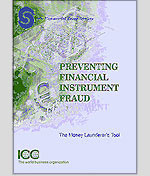
Education Associates, Inc.
A Non-Profit Corporation
|
Quatloos! > Investment Fraud > Treasury Scams & Forgeries > Exhibit: Historical Bond Fraud Exhibit: Historical Bond Fraud Reprinted from: http://www.treasuryscams.gov/cc/ccphony1.htm How Marketable Treasury Securities Really WorkHistorical bonds -- bonds that were once valid obligations of American entities but are now worthless as securities and only collected and traded as memorabilia -- are quickly becoming a favorite tool of scam artists. Here are several things that you should know about them:
Although all sorts of historical bonds are collected and traded, historical railroad bonds comprise the majority of the bonds used to perpetrate fraud. Historical railroad bonds commonly used by scam artists include those issued by the Chicago, Saginaw and Canada Railroad Co., the East Alabama and Cincinnati Railroad Co., the Mad River and Lake Erie Railroad Co., the Galveston, Houston & Henderson Railroad Co. and the Richmond and York River Railroad Co. These railroad bonds are but a few of the 12,000 to 15,000 varieties of historical railroad bonds that are known to exist. Non-railroad historical bonds commonly used by scam artists include bonds issued by the Noonday Mining Co.
Lie: Historical bonds are payable in gold. Lie: Historical bonds are backed by the Treasury Department. Lie: The Treasury Department has established a federal sinking fund to retire historical bonds. Fact: There is no federal sinking fund to retire historical bonds. As these historical bonds were neither issued nor backed by us or any other part of the United States Government, it would be patently absurd to suggest that the U.S. Treasury would establish a sinking fund to retire these historical bonds. Lie: Historical bonds can be used in high-yield investment "trading programs" sanctioned by any, some, or all of the following entities: the International Chamber of Commerce ("ICC"), the IMF, the World Bank, the United Nations, the Federal Reserve Board, a Federal Reserve Bank, and the Treasury Department. Fact: There are no such "trading programs," and none of these entities ever sanctions or regulates such private investment activity. For example, the IMF has issued a warning about financial schemes misusing its name. Lie: Funds in, or some proceeds from, these high-yield trading programs go to humanitarian purposes or infrastructure development projects that are approved by the United Nations, the World Bank, and/or the Treasury Department. Fact: There are no such "trading programs" or "high-yield investment programs." The scam artist's use of humanitarian or infrastructure development theme is a trick to (1) make the investor want to believe that the trading programs are real and (2) make the investor believe that he could be helping some Third World country by forking over his money. Lie: Historical bond trading programs yield high rates of return through the buying and selling of "debentures" or "medium term notes" supposedly issued by "prime" or "top" European or "World" banks. Fact: Officials of leading European banks, including Barclays Bank, have denied any participation in such programs and there is no evidence that the market for such instruments exists as described by the scam artists. This appears to be a recycling of the "prime bank" schemes that have long been labeled as bogus by countless domestic and foreign banking authorities. See, for example, the warnings issued about "prime bank" scams by the Federal Reserve Board, the Federal Reserve Bank of New York and the SEC. Courts have repeatedly held that prime bank trading programs, including those purporting to generate profits through the use of historical railroad bonds, are fictitious. See, e.g., SEC v. The Infinity Group, 993 F. Supp. 324 (E.D. Pa. 1998) (prime bank instruments described as "fantasy securities") (28K TXT file, uploaded 9/28/98); SEC v. Lauer, 52 F.3d 667, 670 (7th Cir. 1995) (such instruments "do not exist") (12K TXT file, uploaded 10/5/98); SEC v. Daniel E. Schneider et al., No. 98-CV-14-D (D. Wyo. February 13, 1998) (order granting preliminary injunction; "prime bank trading schemes are fictitious according to readily available information") (22K TXT file, uploaded 9/25/98).
Once again, historical bonds are worthless as securities. For instance, none of the historical United States railroad bonds are payable by today's successor railroads such as CSX, Norfolk Southern and Union Pacific. Instead, historical bonds only have value as collector's items. A 1995 publication, Stocks and Bonds of North American Railroads: Collectors Guide with Values (one of many available publications) assessed the collector's value of the historical railroad bonds listed above at between $25 and $700 each. Moreover, there are many sites on the Internet, such as Herzog Hollender Phillips & Co. and the Western Mountain Stamp and Coin Shop, that you can visit in order to evaluate the collector's value of any particular bond. These sites are operated by private entities and our reference to these sites is not an endorsement either of these entities or of the values listed on their sites.
Scam artists are selling historical bonds to unsophisticated investors at inflated prices far exceeding their fair value as collectibles. They often use third-party valuations, which state that the bonds are worth million or billions of dollars each, to do so. These valuations or authentications, which are often referred to as "hypothecated" or "hypothetical," are completely bogus. A typical valuation (104K JPG file, file uploaded 1/24/98) will falsely overstate the value of these bonds by assuming erroneously that, notwithstanding the unenforceability of the gold clauses contained in the bonds, as well as the defunct and bankrupt status of most of the bonds' issuers, some person or entity is obligated to redeem the bonds in gold bullion. See SEC v. Gerald A. Dobbins et al., No. 98-229 (C.D. Cal. May 19, 1998) (findings on order to show cause re: preliminary injunction; valuations of historical bonds held to be "misstatements") (8.5K TXT file, uploaded 9/25/98). Scam artists using such valuations may also make the false assertion that while perhaps not payable today in gold or in money, the bonds are used in high-yield trading programs in the United States, offshore and in Europe. As stated above, there are no such trading programs. In several cases, the third parties issuing the valuations appear to be working in conjunction with the scam artists. All of these false assertions have been used to defraud investors into paying as much as $150,000 for historical bonds that regularly trade for $25.
CS&C's creditors forced it into bankruptcy in 1876 and its assets were purchased by a predecessor of CSX Transportation, Inc. ("CSX"). CSX's predecessor did not assume any of CS&C's outstanding debt, including the railroad bonds. All claims to money due under the bonds, which had a face value of $1,000 each, were resolved 112 years ago in the 1876 bankruptcy proceeding. At that time, investors presented their bonds for payment out of funds from the foreclosure sale and received a distribution amounting to less than 25 cents on the dollar. After the bankruptcy proceeding, the bonds remained in court archives until they were discovered in the basement of a federal building. Thereafter, a museum in Grand Rapids, Michigan, packaged the bonds with other historical information about this railroad for sale as collector's items for $29.95 each. Despite what a bogus valuation (104K JPG file, file uploaded 1/24/98) might claim about CS&C bonds, the bonds have no value other than as collectible memorabilia, as CSX has disclaimed any liability for redemption of these bonds, and they are most certainly not payable in gold. See Adams (26K TXT file, uploaded 9/28/98); 31 U.S.C. § 5118(d)(2)(2.5K TXT file, uploaded 9/28/98). Courts have held that the CS&C bonds have only nominal value as collectibles. See Schneider (22K TXT file, uploaded 9/25/98) (preliminary injunction entered against defendants; bonds have "no value, other than that of a collectible"). Similarly, other courts have found that bonds issued in the 1800's by the East Alabama & Cincinnati Railroad Co. and the Marietta & Northern Georgia Railway lack any investment value. See SEC v. Dobbins (C.D. Cal. March 9, 1998) (complaint) (13K TXT file, uploaded 9/25/98); SEC v. Dobbins (C.D. Cal. May 19, 1998) (8.5K TXT file, uploaded 9/25/98) (findings on order to show cause re: preliminary injunction); SEC v. Dobbins (C.D. Cal. May 19, 1998) (preliminary injunction) (7.6K TXT file, uploaded 9/25/98); Infinity Group, 993 F.Supp. at 330 (28K TXT file, uploaded 9/28/98). Investors should beware of the prevalent fraud in the area of historical bonds. As fraud artists have made considerable sums of money in this fraud, it is one of the largest growing areas of fraud involving stocks or bonds. We suggest that you contact the Office of the Chief Counsel, Bureau of the Public Debt, Department of the Treasury at 304-480-8555 for further information. |
How to Protect Yourself from Investment Scams How Marketable Treasury Securities Really Work We do NOT spam. Various multi-level marketers & other criminals have recently sent out spam impersonating us, & having our return email address, so that people would complain about spam and cause us to be shut down (a/k/a "joe job"). These multi-level marketers and other criminals have engaged in this form of cyber-terrorism because our telling the truth about their fraudulent schemes was hurting their ability to sell to new victims. Fortunately, our ISP now recognizes that these fake spams are bogus and ignores them, and additionally we are duplicating this site on numerous other servers (including "hardened" servers as well as our own proprietary servers) so that we cannot be harmed by these multi-level marketers and other criminals. Death to Spammers! "Preventing Financial Instrument Fraud" -- prepared by the ICC Commercial Crime Services, the anti-crime arm of the International Chamber of Commerce. This unique reference guide uncovers the mysterious world of High Yield Investment Programs (HYIP) and Financial Products such as Letters of Credit, Bank Guarantees, CD's, Safe-Keeping Receipts and more as used by Fraudsters. By Jon Merrett and Paul Renner |
 |
© 2002- by Quatloosia Publishing LLC.. All rights reserved. No portion of this website may be reprinted in whole or in part without the express, written permission of Financial & Tax Fraud Associates, Inc. This site is http://www.quatloos.com. Legal issues should be faxed to (877) 698-0678. Our attorneys are Grobaty & Pitet LLP (http://grobatypitet.com) and Riser Adkisson LLP (http://risad.com).
 |
 |
 |
 |
| www.assetprotectionbook.com | www.farbook.com | www.eiabook.com | Lost Eye Book |
Website designed and maintained by John Barrick





